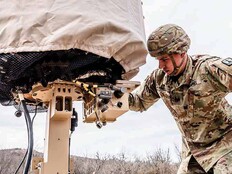Feds Ramp Up Robotic Process Automation Efforts
Robotic process automation is evolving from a curiosity in the federal government to a technology that is receiving serious attention.
RPA allows organizations to automate certain repetitive tasks — often mundane and tedious work that users do not want to spend much time doing. It is still relatively nascent in the government, but it is more prevalent in the private sector.
In April, the General Services Administration created a community of practice (CoP) for RPA to help federal leaders "explore opportunities, share ideas, and collaborate on how RPA can be effectively implemented in their respective agencies,” Ed Burrows, robotics process automation program manager at GSA, wrote in an agency blog post.
So far, RPA has not produced dramatic cost savings, but will over time as some jobs are eliminated and federal employees are put to work on more high-value tasks. Federal CIO Suzette Kent said last month that agencies should plan to reinvest those savings into other IT projects.
GSA Aims to Spur RPA Adoption Across Government
Many agencies are piloting RPA or have bots in production, Burrows notes in the blog post. “With the advancements in emerging technology, it’s important for the federal government to capitalize on technological solutions in order to obtain the benefits of cost-effectively automating manual, repetitive, and rule-based operations,” he says.
Yet, according to Burrows, there is much more that agencies can do with RPA by collaborating together and with industry.
RPA will help agencies shift from low-value to high-value work, one of the cross-agency priority goals in the President’s Management Agenda. An August 2018 Office of Management and Budget memo specifically cites RPA as one of the technologies that can be used to cut the number of repetitive administrative tasks agencies perform.
RPA will help agencies in several other ways, Burrows argues. These include re-engineering and improving processes as they are automated; increasing the efficiency of existing operations; cutting costs over time by allowing agencies to maintain the quality of work and take on new tasks without hiring additional personnel; and reducing errors and costs connected to work delays.
“By creating an RPA CoP, the federal government can reduce duplication and streamline efforts to implement RPA across government to help advance agency missions today, and into the future,” Burrows says.
MORE FROM FEDTECH: Find out how voice assistants can streamline customer service for agencies.
Agencies Can Put Savings from RPA into Tech Modernization
For agencies to reinvest savings from RPA, they will need to appropriately track the budget and workforce effects of it, Kent said, according to FedScoop. Those savings need to be quantified and would then need to go into a working capital fund, authorized via the 2017 Modernizing Government Technology Act.
Just six agencies have created working capital funds: the Department of Education, the Department of Labor, the Department of the Treasury, the General Services Administration, the Small Business Administration and the Social Security Administration, according to an April report from the Government Accountability Office.
“There’s a whole structure for how it works,” Kent said after the 2019 Department of Labor Tech Day, according to FedScoop. “What we still have to do is get more precise in how the benefits are generated and making sure we can capture those and reinvest them.”










